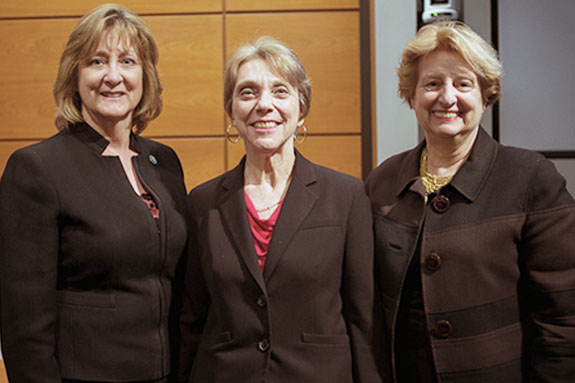By 2050, the United Nations (U.N.) projects that almost three-quarters of the world’s population will call urban areas home.1 The U.S. Census Bureau estimates that, in the same period, the nation’s population will grow by 80 million people, 60 million of whom are likely to live in urban areas.2
While cities are rich with possibility, they are also the places where the challenges of income inequality, economic and racial segregation, and lack of affordability persist. How to overcome these challenges and create a path for sustainable development — a concept that means “development that meets the needs of the present without compromising the ability of future generations to meet their own needs”3 — will be the topic of this year’s U.N. Conference on Housing and Sustainable Urban Development, Habitat III, to be held in Quito, Ecuador, from October 17 through 20.4
Habitat III is an opportunity to think and act with a collective voice in the effort to create and sustain cities of opportunity. More specifically, Habitat III is an opportunity for the U.S. to leverage the collective expertise of those addressing sustainable development globally and establish shared priorities domestically
International Convening to Promote Sustainable Urban Development
Habitat III differs from the preceding Habitat conferences, Vancouver (1976) and Istanbul (1996), with its attention on the integration of civil society stakeholders in the preparations leading up to the conference and its focus on implementation as the ultimate goal of the Quito event.
This conference, which happens once every 20 years, will be the first U.N.-wide conference convened after the approval of two important global agreements: the 2030 Agenda for Sustainable Development with 17 sustainable development goals, including one focusing on creating safe, inclusive, resilient, and sustainable cities; and the Paris Agreement, a legally binding contract to address global warming. For its part, Habitat III will produce a New Urban Agenda, an outcomes-based document that outlines aspirations for reaping the benefits of urbanization while addressing its challenges.
The New Urban Agenda,5 as a U.N. document, will represent a broad global consensus about policy directions for the next 20 years that member states can use to guide their own domestic policies and participate in international aid programs. It will recognize that urban areas contain 54 percent of the world’s population, rising to 60 percent or more by 2030; generate 70 percent to 80 percent of the global domestic product (GDP); and account for 70 percent to 80 percent of energy consumption and greenhouse gases.6 In the U.S., whose population is 83 percent urban, the contributions of metropolitan areas to GDP and energy consumption match these global figures. The New Urban Agenda will identify challenges to be addressed, including poverty and inequality, environmental degradation, and barriers to economic productivity.
In the U.S., the federal government and civil society stakeholders have been active in preparations for the conference, which have been underway for more than two years. In December 2014, the U.S. Department of State, in partnership with the U.S. Department of Housing and Urban Development (HUD), launched a multistakeholder national committee to help shape the arrangements for the conference. More than 40 agencies and organizations, ranging in size and geographic footprint, are participating in the U.S. National Committee for Habitat III, which is chaired by HUD Secretary Julián Castro.7
The committee has developed a three-part program to heighten awareness of and ultimately strengthen U.S. participation in Habitat III, including a national campaign to convene regional conferences throughout the nation; a global conversations seminar series taking place in Washington, D.C.; and amplification of the U.S. national report submitted to the U.N.8
In fulfilling its commitment to facilitating a dynamic and inclusive preparatory process, HUD’s regional offices and partners convened five regional conferences in Chicago, Denver, Miami, Philadelphia, and El Paso, TX, from March to July 2016. Among other things, feedback from the conferences was shared with the U.S. Department of State and integrated into the final version of the U.S. National Report for Habitat III. The feedback also helped shape the U.S. statement on the floor of the U.N. in June that called for the New Urban Agenda to be an action-oriented document focused on correcting social, economic, and environmental imbalances, yet supporting equality, prosperity, and eco-friendly development.
Philadelphia Gathering to Set Regional Priorities
In Philadelphia, approximately 150 individuals attended “The City We Want & Need: A Mid-Atlantic Regional Convening on Habitat III,”9 which was co-hosted by HUD’s Philadelphia and New York Regional Offices and the University of Pennsylvania’s Penn Institute for Urban Research and Perry World House. The event, which was held at the University of Pennsylvania on May 17, 2016, included three keynotes; three interactive panels; and closing comments from Nancy Stetson, the U.S. Department of State’s special representative for global food security and the lead U.S. negotiator on Habitat III.
In a keynote address, Amy Liu, vice president and director of the Metropolitan Policy Program at the Brookings Institution, emphasized the necessity of creating pathways to inclusive prosperity as a means to the successful implementation of the New Urban Agenda in the U.S. She showed how to align community and economic development to create quality jobs and neighborhoods by investing in innovation and inclusionary skills development. She noted that, even though the U.S. has achieved strong economic growth since 2009, the typical worker’s wages have actually declined in most U.S. metropolitan areas, a fact that has contributed to widening disparities in income.
Liu also said that some metros, epitomized by Philadelphia, are performing poorly with respect to lowering poverty and increasing social mobility. To counteract these trends, metropolitan areas must help workers adjust to the new realities of technology, globalization, and demographic change, an approach that requires strategic coordination of key systems — economic, social, and physical. Education, community development, and infrastructure must be aligned by public, nonprofit, and private entities at regional and community levels to create growth and opportunity. Liu cited several examples of such an alignment, including the Kentucky Federation for Advanced Manufacturing Education (KY FAME), Motor City Match in Detroit, i.c.stars and the Greater Chatham Initiative in Chicago, and the Baltimore Regional Housing Partnership.10 All of these programs encompassed skills development, job training, and housing development. Subsequent sessions at the event included Investing in People and Communities for Social Mobility, Securing Housing Options for All, and Responding to Change & Building Resilience.
In highlighting several local challenges to sustainable urban development, the speakers at the regional conference reminded the participants that, while the provisions in the New Urban Agenda will be universally applicable, localities will need to adjust their responses according to their unique conditions. For the Philadelphia region, decision makers will likely focus on pursuing critical issues of economic development, housing affordability, education, and resilience.

Leaders of a mid-Atlantic regional convening on the Habitat III conference, held in Philadelphia in May 2016, included (left to right) Jane C.W. Vincent, Regional Administrator, Region III, U.S. Department of Housing and Urban Development; Nancy Stetson, Special Representative for Habitat III, U.S. Department of State; and Eugenie L. Birch, Lawrence C. Nussdorf Professor of Urban Research and Education, Department of City and Regional Planning, and Co-Director, Penn Institute for Urban Research, University of Pennsylvania.
Photo Credit: Jessica Kourkounis Photography
The views expressed here do not necessarily represent the views of the Federal Reserve Bank of Philadelphia or the Federal Reserve System.
[1]United Nations, Department of Economic and Social Affairs, Population Division, “World Urbanization Prospects: The 2014 Revision, Highlights,” (ST/ESA/SER.A/352), 2014, available at https://esa.un.org/unpd/wup/Publications/Files/WUP2014-Highlights.pdf.
[2]Sandra L. Colby and Jennifer M. Ortman, “Projections of the Size and Composition of the U.S. Population: 2014 to 2060,” Current Population Reports, P25-1143, U.S. Census Bureau, Washington, D.C., March 2015, available at www.census.gov/content/dam/Census/library/publications/2015/demo/p25-1143.pdf.
[3]World Commission on Environment and Development, Our Common Future, Oxford: Oxford University Press, 1987. Commonly referred to as the Brundtland report, after the name of the chair of the commission.
[4]For more information about the conference, visit www.habitat3.org/.
[5]To learn more about the New Urban Agenda and to read a draft, visit www.habitat3.org/the-new-urban-agenda.
[6]Data compiled by HUD’s Office of Policy Development and Research.
[7]A list of members of the U.S. National Committee for Habitat III may be found at www.huduser.gov/portal/sites/default/files/pdf/HUD-Habitat-III-Overview.pdf.
[8]Information about this effort is on the HUD website at www.huduser.gov/portal/ipi/habitat-iii.html.
[9]For information about this event, including videos of the presentations, visit http://portal.hud.gov/hudportal/HUD?src=/states/pennsylvania/library/virtualhabitat.
[10]For information about these programs, see http://kyfame.com/ (KY FAME), www.motorcitymatch.com/ (Motor City Match), www.icstars.org/ (i.c.stars), and www.brhp.org/ (Baltimore Regional Housing Partnership). To learn about the Greater Chatham Initiative, read the June 29, 2016, press release from the City of Chicago at http://ow.ly/Gks2303txzm.
